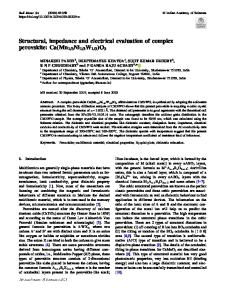Electrical and structural properties of ABO 3 /SrTiO 3 interfaces
- PDF / 248,424 Bytes
- 6 Pages / 432 x 648 pts Page_size
- 15 Downloads / 372 Views
Electrical and structural properties of ABO3/SrTiO3 interfaces A. Kalabukhov1,4, T. Claeson1, P.P. Aurino1, R. Gunnarsson1, D. Winkler1, E.Olsson2, N. Tuzla2, J. Börjesson2, Yu.A. Boikov3, I.T. Serenkov3, V.I. Sakharov3, and M.P. Volkov3 1
Dept. Microtechn. and Nanosci. (MC2), Chalmers Univ. Techn., 41296 Gothenburg, Sweden Department of Applied Physics, Chalmers Univ. Techn., SE-41296 Gothenburg, Sweden 3 Ioffe Physico-Technical Institute Russian Academy of Sciences, 194021 St. Petersburg, Russia 4 Skobeltsyn Inst. Nuclear Physics, Dept Physics, Moscow State Univ., 119899 Moscow, Russia 2
ABSTRACT Electrical transport and microstructure of interfaces between nm-thick films of various perovskite oxides grown by pulsed laser deposition (PLD) on TiO2- terminated SrTiO3 (STO) substrates are compared. LaAlO3/STO and KTaO3/STO interfaces become quasi-2DEG after a critical film thickness of 4 unit cell layers. The conductivity survives long anneals in oxygen atmosphere. LaMnO3/STO interfaces remain insulating for all film thicknesses and NdGaO3/STO interfaces are conducting but the conductivity is eliminated after oxygen annealing. Medium-energy ion spectroscopy and scanning transmission electron microscopy detect cationic intermixing within several atomic layers from the interface in all studied interfaces. Our results indicate that the electrical reconstruction in the polar oxide interfaces is a complex combination of different mechanisms, and oxygen vacancies play an important role. INTRODUCTION High electrical conductivity and mobility was reported for polar LaAlO3 (LAO) deposited on top of SrTiO3 (STO) when the LAO film thickness exceeded a critical value of 3-4 unit cells (uc) [1,2]. Conductivity is sensitive to oxygen pressure during deposition [3]; the interface is insulat-ing if fabricated at pressure above 10-2 mbar [4]. Metallic interfaces prepared at 5x10-2 mbar O2 have, however, been reported [5]. The conductivity survives long anneals in oxygen atmosphere and high temperature [6]. The complicated behavior of LAO/STO interfaces is difficult to explain using a single model. The critical thickness, the role of substrate termination and polar overlays [7] point towards intrinsic doping due to polar discontinuity [8]. Strong oxygen pressure dependence indicates doping by oxygen vacancies in the STO substrate [4,9]. Cationic intermixing between La and Sr may also contribute to electrical doping [10-12]. Properties of other polar interfaces were recently reported. LaGaO3/SrTiO3 shows similar properties to LAO/STO, including 4 uc critical thickness [13]. Conductivity is eliminated, however, after annealing in oxygen atmosphere. In contrast, polar interfaces, such as LaMnO3/STO and DyScO3/STO are insulating independent of film thickness and fabrication [13-15]. There is still no generic model to explain why some interfaces are conducting while others are not. A comparison of microstructure and electronic configuration is required to gain better understanding of the occurrence of an electron liquid. We fabricate and
Data Loading...











